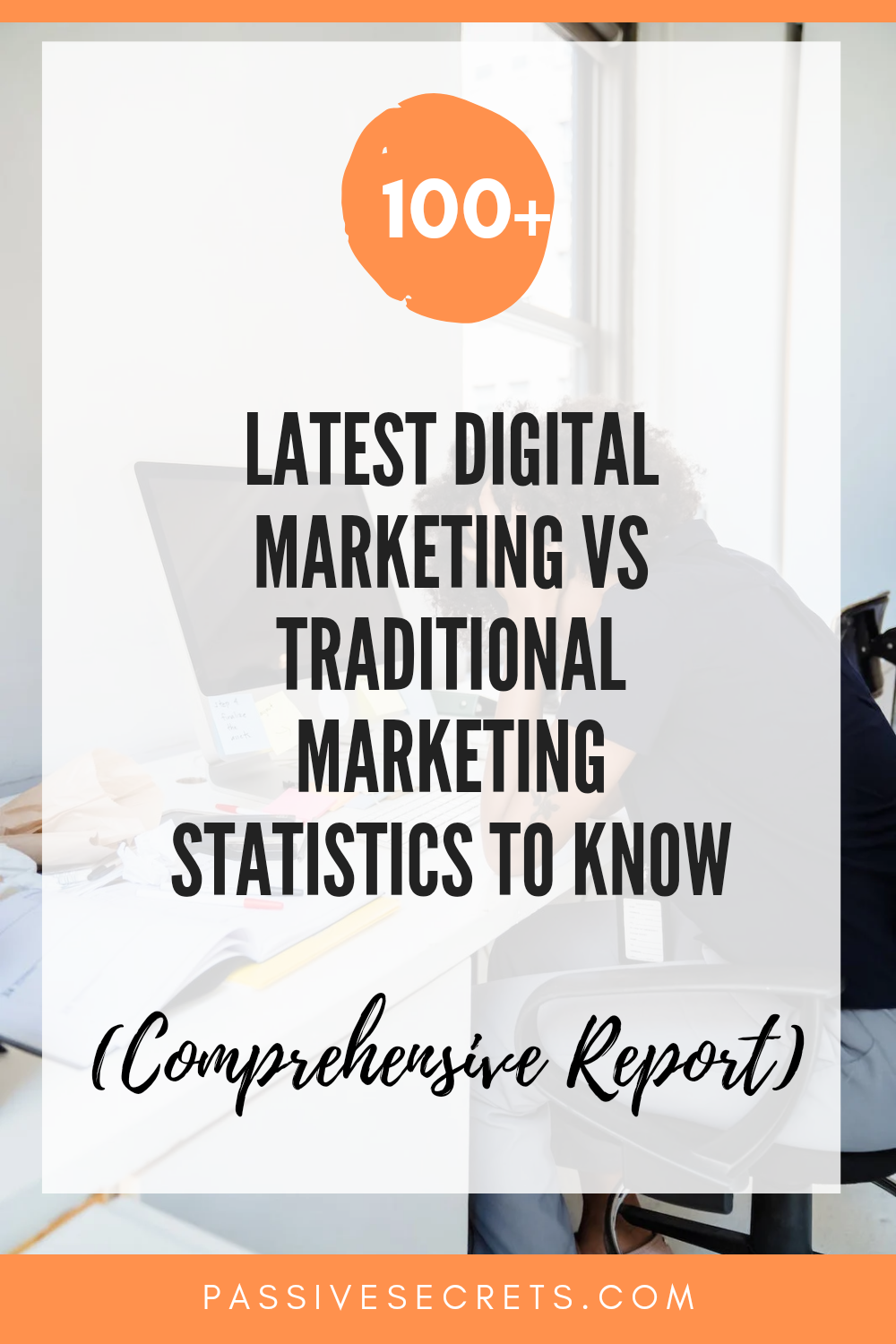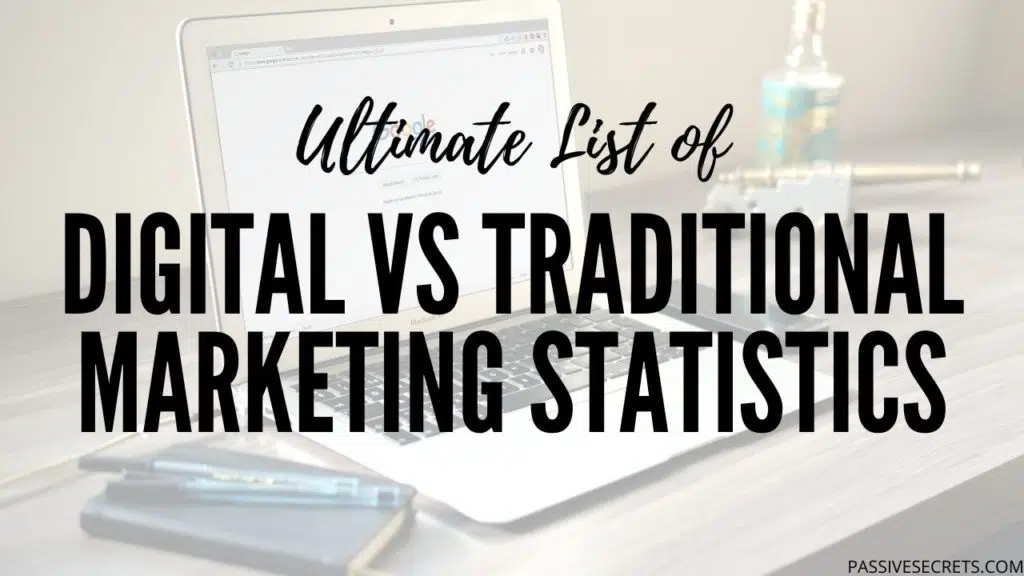
Digital advertising has slowly but steadily taken over the place of traditional marketing. As we go further into the years, only a few companies still include traditional advertising as part of their marketing strategy.
However, most marketers are confused about whether to continue with traditional or digital advertising.
To determine which marketing strategy is better, let’s look at insightful digital marketing vs. traditional marketing statistics.
You will see top digital and traditional advertising examples (and statistics) to help you decide which advertising is better.
Digital Marketing Vs Traditional Marketing Stats 2024
Both digital marketing and traditional advertising are important to your marketing strategy.
However, most marketers do not know if they should invest in the latter or the former.
Through these statistics, we critically examine insightful facts to help you decide which strategy is most suitable. However, what matters most is the quality of your marketing.
Every year, businesses spend so much on brand advertising.
In fact, U.S.-based businesses spent over $793 billion in advertising in 2021. Thus making the U.S. the country with the largest advertising industry globally.
Additionally, the revenue of the U.S. ad industry is growing rapidly. In 2021, the revenue was valued at $304 billion, which will increase by 2.6% in 2023, amounting to $352 billion.
Top Digital Marketing Statistics 2024
Digital marketing is also known as online marketing. It is any form of advertising done online, i.e., via the internet. Examples of digital marketing include:
- Email marketing
- Social media advertising
- Search engine marketing (PPC & SEO)
- Native advertising
- Digital display advertising
- Mobile advertising
General Online Advertising Statistics
1. A survey showed that what B2B product marketers in the U.S. spend on digital marketing is expected to increase by 8.77%. However, traditional advertising spending is expected to decrease by just 3.64%. (source)
Unless you live under a rock, you must have noticed that every marketer has geared towards the digital market space.
About 20 or 30 years ago, traditional marketing was the hotcake in the advertising industry.
However, with the advancement of technology, the dynamic has changed to become digital-inclined. As you will see from the statistics below, this dynamic is not changing anytime soon.
2. The global digital marketing market is expected to reach about $786.2 billion by 2026. (source)
3. The U.S. digital marketing market value is $460 billion as of 2022. (source)
As the world is still adapting to the changes caused by the Covid-19 pandemic, digital marketing is set to skyrocket.
Companies are finding various ways to expand their audience reach and be in their customers’ faces daily.
4. About 78% of direct brand marketers believe digital marketing is critical to their overall marketing efforts. (source)
5. The annual growth rate for digital marketing between 2020 to 2026 is estimated at 9%. (source)
6. The U.S. retail e-commerce revenue was estimated at $768 billion in 2021. However, this value is expected to increase by 2025 to about $1.3 trillion. (source)

7. By the end of 2022, the U.S. retail e-commerce market was projected to be worth up to $986.10 billion. (source)
This is an increase of over 15% from 2021 revenue. As more companies take up digital marketing, the revenue will increase. If you have not fully invested in digital marketing, now is a great time to go deep.
8. The user penetration in the digital marketing space is expected to hit 80.1% by the end of 2022 and 83.6% by 2025. (source)
9. Over 70% of business marketers actively invest in content marketing. (source)
10. 89% of global marketers say that short-form video content is worth investing in, and they agree to continue investing in it. (source)
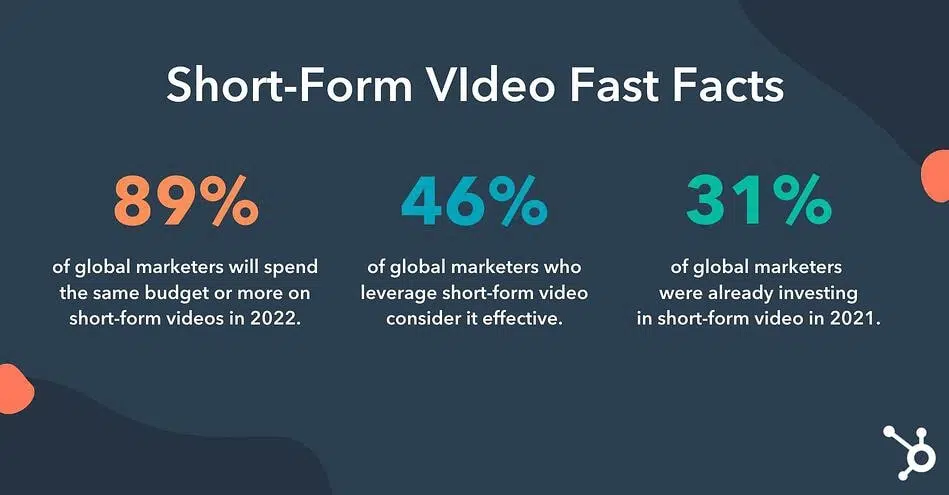
11. In 2019, over 22% of all digital ad spending was in retail. Thus making retail the industry with the largest digital ad spend. (source)
12. 60% of adult podcast listeners reported taking action on an ad after hearing it on a podcast. Also, about 74% of monthly (active) podcast listeners say they turn to podcasts to learn about new things. (source)
13. According to recent research, over 72% of the marketing budget is allocated to digital ad channels. (source)
Digital Display and Outdoor Advertising Statistics
Banner advertising is one of the most popular forms of digital advertising. They are done in various forms, from pop-ups to wallpapers and even skyscrapers.
14. The global banner advertising spending was $158.2 billion as of 2022, and there was a growth rate of 12.8% in ad spending. (source)
15. The U.S. generated the most spending for banner ads in 2022, with about $61 billion. With that figure, the average banner ad spend on the internet per user amounted to $30.99. (source)
16. As of 2021, the UK was the largest market for digital display ads in Europe. The market is worth up to €14.8 billion. Germany is in second place with a digital display ad market worth up to €5.6 billion. (source)
17. The U.S. digital outdoor advertising spending amounted to $2.72 billion in 2020. This is expected to increase to $3.84 billion by 2023. (source)
18. Global digital outdoor ad spending is expected to increase from $6.7 billion in 2019 to about $15.9 billion in 2027. (source)
19. In 2021, the revenue for digital outdoor ads in the UK accounted for 64% of the overall revenue from outdoor ads in the country. (source)
20. The programmatic digital outdoor advertising spending increased to $530 million in 2022. This was a rise from the spending in 2020, which was valued at $180 million. (source)
21. Over 57% of U.S.-based consumers say that they pay attention to digital outdoor ads, especially billboards and street-level ads. (source)
22. Consumers are 155% more likely to look up a brand’s specific terms after they have been exposed to display ads (source)
23. 50% of ad clicks happen on mobile devices (source)
24. 70% of consumers are more likely to purchase products that are retargeted at them through display ads (source)
Email Marketing Statistics
25. The global email advertising market value was estimated at $7.5 billion in 2020. The market value is expected to increase to $17.9 billion by 2027. This is at a CAGR of about 13.3%. (source)
With over 4.14 billion email users worldwide, email advertising stands a huge chance of growing and reaching more people.
26. The average time consumers spend reading brand emails is 10 seconds. This is a decline from the reading time of 13.4 seconds in 2018. (source)
As the reading time keeps declining, your emails need to be captivating from the first few words. No one wants to waste time reading what they don’t care about.
27. As of 2021, over 65% of surveyed marketers say they use automation in their email marketing campaigns. (source)
28. The global marketing email click-through rate (CTR) is 2.6%. Moreover, Australia is the region with the highest share of marketing email CTR, with a rate of 3.1%. (source)
29. About every 5 in 10 surveyed consumers say that they prefer to be contacted by business brands via email. This is approximately 50% of surveyed consumers. (source)
30. MailChimp is the world’s No.1 B2B email marketing SaaS company. It has an annual recurring revenue of $800 million. The second spot goes to ActiveCampaign, with a yearly income of $165 million. (source)
31. Email marketing is used by 1 in 2 media planners, and about 22% of media planners intend to leverage it for the first time. (source)
32. In 2022, more than 333 billion emails were sent and received daily. This figure is expected to increase to 392.5 billion by 2026. (source)
33. For every $1 spent on email marketing, there is a $36 return on investment. (source)
34. About 90% of brands consider email marketing to be critical to their success as a brand. (source)
35. Email marketing is one of the most effective mediums for marketing, with 79% of marketers placing it as 1 of the 3 marketing strategies. (source)
Social Media Marketing Statistics
36. From a survey conducted in 29 countries, 83% of surveyed marketers say that they use social media as a primary digital channel for their marketing strategy. (source)
37. Over 91.9% of U.S. marketers in big-scale organizations use social media platforms as marketing platforms. (source)
38. Social media marketing spending in the U.S. peaked at over $80.67 billion in 2022. But, globally, the market spend was estimated to be valued at $230.30 billion. (source)
39. The annual ad spend is expected to grow at a CAGR of 11.99%. This growth will increase the market volume, estimated at $362 million by 2026. (source)
40. The ad spending in the UK reached $12.16 billion in 2022. The UK social media ad spend grew at a CAGR of 9.28%. This will lead to a market volume of $17.34 billion by 2026. (source)
41. The social media market size is estimated at $72.2 billion. (source)
42. Businesses spend about 17% of their marketing budget on social media. (source)
43. The average US adult spends about 2 hours and 25 minutes daily on social media. (source)
Mobile Advertising Statistics
44. Mobile advertising spend has about 58% share of digital ads. The share is expected to increase to 68% by 2025. (source)
45. In 2018, over 92% of Facebook’s ad revenue came from mobile. This is an increase from the 88% of ad revenue generated from mobile the previous year. (source)
46. 69% of surveyed marketers say they use mobile channels in their digital marketing strategies. (source)
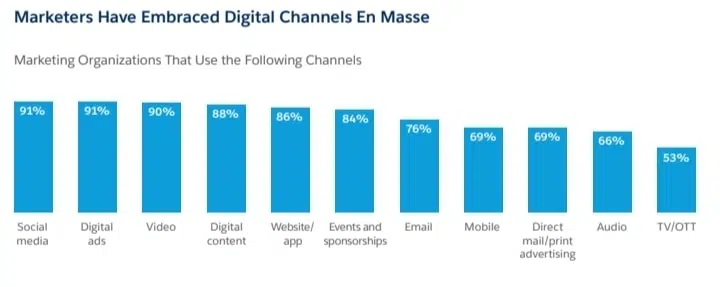
47. Mobile social media advertising is the biggest form of mobile advertising. It is expected to have a market spending value of $141 billion in 2022. (source)
48. In February 2020, businesses spent 13.5% of their marketing budget on mobile marketing. (source)
However, it increased to 23% in June of that same year. With a continuous rise, marketers expect to spend 35.7% of their marketing budget in the next five years.
49. The current global mobile advertising spend is $288 billion. The spending is expected to increase to $413 billion by 2024. (source)
Businesses are increasing their budgets for mobile advertising. This is mostly because consumers prefer to access the internet through their smartphones.
The amount of time people use their smartphones is rapidly increasing every year.
Native Advertising Statistics
50. The global market worth for native advertising is expected to be $400 billion by 2025. This is an increase of 372% from 2020 to 2025. (source)
51. The native digital display ad spending in the U.S. reached $35.24 billion in 2018. It increased to $52.75 billion in 2020. (source)
52. About 68% of consumers trust native ads and content in an editorial context. This is higher than the 55% who trust social media ads. (source)
53. Surveyed consumers found it 62% easier to understand native ads than display ads. They also found it 31% easier than social media ads. (source)
54. Native ad recommendations are 27% more trusted than social media ads. (source)
Search Engine Marketing Statistics
Search engine marketing is paid SEO. It is a marketing strategy that combines the power of paid search and search engine optimization to boost brand visibility on search engines.
This section also contains some insightful PPC statistics and organic vs paid search statistics to understand search engine marketing better.
55. Google is a leader in the search engine market. It has an 85% global market share of all desktop searches. Also, Google has a 98% global market share of mobile searches. (source)
56. The first five results on search engines account for more than two-thirds of all clicks. This is approximately 67.6%. (source)
Search engine marketing is a powerful digital advertising strategy for putting you directly in front of your target audience.
57. Google holds 91.61% of all global online searches. (source)
Google is the number one search engine in the world. Your search engine marketing strategy should be optimized for Google if you want to see tremendous results.
Traditional Advertising Statistics
Traditional advertising is the opposite of digital marketing. It is any form of marketing that is done physically — offline. Another word for traditional advertising is offline marketing.
Examples of traditional advertising include:
- Print advertising (Newspapers and print magazines)
- Broadcast marketing (Television & Radio advertising)
- Cold calling
- Traditional outdoor advertising
- Direct mail marketing
General Traditional Advertising Statistics
58. The U.S. B2B traditional ad spending in 2022 was $17.7 billion. This is a 5.8% increase from the value in 2021. (source)
The total spend is expected to rise to $19.2 billion by 2024.
59. Between February 2012 and February 2022, a reported annual decrease of -1.4% in traditional advertising spending was reported. However, traditional marketing spending is expected to increase by 2.9%. (source)
60. About 50% of consumers prefer to buy online and then pick up what they purchased in-store. (source)
Radio Advertising Statistics
61. More than 90% of the U.S. radio ad revenue from 2006 to date (2022) has been generated by OTA (over-the-air). (source)
However, the remaining 10% (or less than 10%) of revenue is generated online.
62. The retail industry is the second-largest radio ad industry, as companies in this industry spent about $316 million on radio ads in 2019. (source)
63. The radio market worldwide grew from $18.34 billion in 2021 to over $19.58 billion in 2022. This is a compound annual growth rate of about 6.8%. (source)
64. By 2026, the global radio market will increase to $23.43 billion. This is at a compound annual growth rate (CAGR) of about 4.6%. (source)
65. 46% of radio listeners say they have considered patronizing a new product, service, or even a new company after listening to a radio ad. (source)
66. By 2021, the overall radio ad spending in the U.S. was estimated to be $11 billion. Additionally, there was a 3% increase in 2022. (source)
Television Advertising Statistics
Before the emergence and popularity of the Internet, television was the most popular and most effective advertising platform.
Advertising your products and services on television allows you to reach millions of viewers worldwide.
It was more effective than print media and radio because of television’s audio-visual abilities.
Due to the emergence of the internet and social media, television is no longer the primary source of entertainment and news.
Therefore, the number of viewers you could reach via television advertising has reduced.
67. In 2020, the television advertising spend in North America was valued at $65 billion. (source)
68. Due to the Covid-19 pandemic, the revenue for the global television advertising market dropped to $141 billion in 2020. (source)
69. The global TV advertising revenue was estimated at $151 billion in 2021. However, this figure rose to $159 million in 2022. (source)
Even though TV advertising lost its No.1 top advertising medium spot to the Internet, it is still the second-largest advertising medium. It beats print media.
70. North America is the region with the highest TV ad spend. The region had a total television advertising spend of $64.5 billion in 2021. (source)
71. The TV ad revenue, in the U.S. alone, was valued at $72.3 billion in 2021. This is expected to raise $81 billion by 2025. (source)
This statistic just goes to show that TV advertising is still very effective.
More marketers still use television to advertise their products and services.
72. The TV penetration rate in the U.S. is 71%. The penetration rate dropped by 10% between 2014 and 2021. (source)
The drop is expected to continue as long as people prefer to subscribe to video streaming services, rather than pay TV services.
73. The United Kingdom has the highest TV ad spend in Central and Eastern Europe (CEE). (source)
74. In 2021, the TV ad revenue in the UK was worth £5.38 billion. (source)
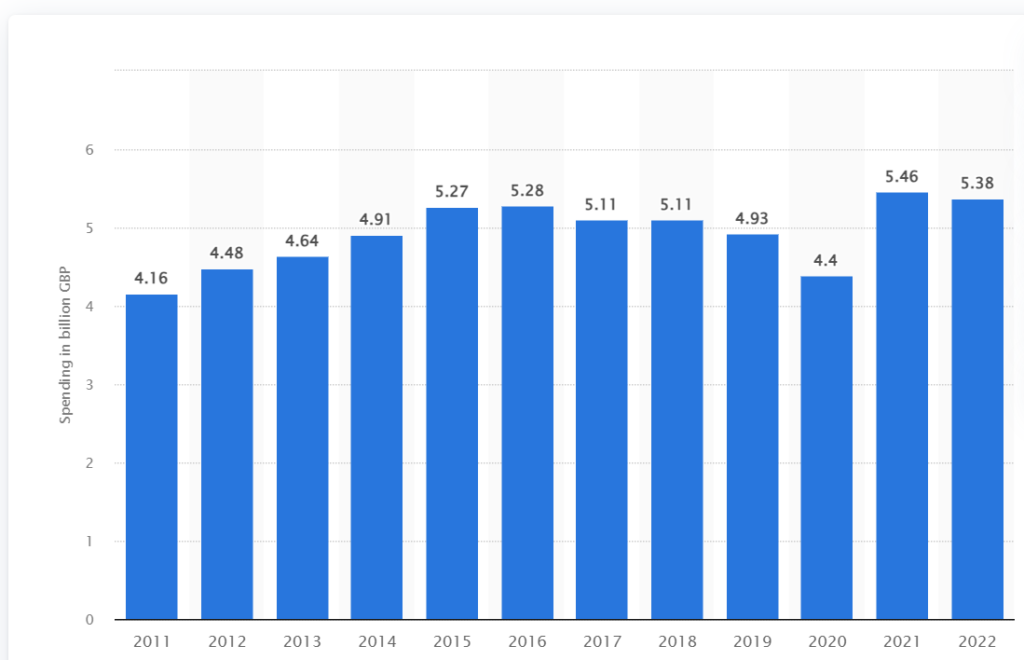
75. In 2020, during the Covid-19 pandemic, the traditional TV ads spent in South Africa were worth $379 million. (source)
This figure signified a $100 million decrease from the value estimated in 2019.
Nonetheless, the amount is not permanent. TV ad spending is expected to increase to $550 million by 2025.
Out-of-home Advertising Statistics
Out-of-home advertising is also known as outdoor advertising. The advertising formats include posters, stadium and arena advertising, digital billboards, and in-flight advertising.
This type of advertising is designed to reach potential customers outside their homes.
76. The global outdoor advertising spending reached over $34 billion in 2021. The value is expected to increase and amount to $42 billion by 2024. (source)
Although originally a traditional advertising medium, outdoor advertising gradually shifted to digital formats. This shift is what is contributing to the increase in ad spending.
77. JCDecaux is the largest outdoor advertising firm globally, with over $3.2 billion in revenue in 2021. (source)
The second spot goes to the Clear Channel Outdoor Company, which generated a revenue of $2.2 billion.
78. As of 2021, the U.S. spending on outdoor advertising amounted to $6.96 billion, increasing by 14.5% from the previous year. (source)
79. In the U.S., street furniture outdoor advertising generated about $101 million. This revenue was generated in the third quarter of 2021. (source)
80. Billboards are the outdoor ad type with the highest reach in the U.S., with about 80% of consumers saying they notice a billboard ad. Printed signs advertising in physical venues followed closely in second place. (source)
81. The global billboard & outdoor market is expected to be valued at $66.80 billion by 2022. (source)
This is a compound annual growth rate of 8.3%. Also, the market is expected to be valued at $87.76 billion by 2026. This is with a CAGR of 7.1%.
The increase is due to the companies recovering from the impact of the Covid-19 pandemic and its economic effects.
82. As of 2020, the total number of billboards in the U.S. amounted to 343,106. This number later grew to over 351,000 by the end of 2021. (source)
83. In a survey of over 611 marketers in the U.S., 84% predict a rise in more interactive outdoor ads. 60% of surveyed marketers say that the decline in digital ads is due to digital fatigue in consumers. (source)
84. 92% of surveyed marketers increased their outdoor advertising in 2022. (source)
85. In the U.S., McDonald’s led the out-of-home advertiser rank with an ad spend of $59.9 million. Apple closely followed in the rank with $57 million. (source)
Cold Calling Advertising Statistics
Cold calling simply means marketing products and services to potential customers through phone calls. Another word for cold calling is telemarketing.
86. Over 41% of surveyed marketers and business professionals say that they still prefer phone calls for communication. (source)
Phone calls are still the preferred means of communication for marketers, especially due to increased remote jobs and limitations on face-to-face interactions.
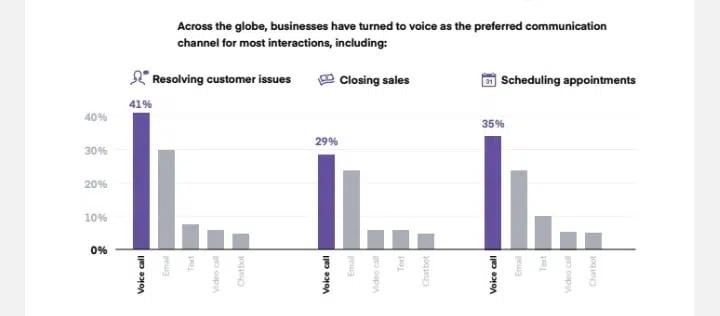
87. About 45% of surveyed businesses say that phone calls for advertising and communication have increased over the last year. (source)
88. The best time of the day to call prospective customers is between 4 pm and 5 pm. (source)
However, ensure you don’t make your calls on Mondays. Not everyone is in their best mood on a Monday. Based on research, the best day to call is on a Wednesday.
89. Over 93% of a cold call’s potential success depends on the tone of the caller’s voice. (source)
As a marketer, your tone greatly affects how the call receiver receives you at the other end.
Since they cannot see you physically, they use your voice to determine if they should listen to you or not.
Print Marketing Statistics
The print advertising industry comprises consumer magazines, newspapers, posters, and banners.
All of these forms are in physical print. The digital versions are excluded.
90. There was a decline in the global print market value from about $31.84 billion in 2021 to $31.63 billion in 2022. (source)
The decline was at a compound annual growth rate of -0.7% during this period. Also, the decline in the market value is expected to continue and amount to $28.40 billion by 2026.
91. The global ad spend for print advertising was about $50.38 billion in 2022. (source)
92. In 2020, the U.S. newspaper ad revenue was estimated at $10.22 billion. This figure is a decrease from the 2019 revenue, estimated at $11.65 billion. (source)
93. The global ad spend in the magazine advertising segment amounted to $14.79 billion in 2022. (source)
However, there would be a decrease in this amount. By 2026, declining ad spending of -6.08% will result in a market volume of $11.51 billion.
94. By 2026, the total number of print magazine readers is expected to be 967.3 million users. (source)
95. Newspaper advertising is the largest segment of print advertising. It had a market volume of $35.59 billion in 2022. (source)
96. Newspaper ad spending is expected to decline at a CAGR of 4.45% between 2022 and 2026. (source)
Thus, the market volume is expected to be valued at $29.67 billion before the end of 2026.
97. In the newspaper marketing segment, the average ad spend per reader reached $25.38 in 2022. (source)
98. The total number of print newspaper readers, worldwide, is expected to reach over 1.2 billion by 2026. (source)
99. The newspaper ad spending in the U.S. amounted to $6.03 billion in 2022. (source)
Ad spending is expected to reach $4.06 billion by 2026. This is at a negative CAGR of -9.41%.
Direct Mail Advertising Statistics
Direct mailing is more like the offline form of email marketing.
In direct mail marketing, you send physical sales materials to your customers or prospects.
The sales materials can include sales brochures, discount coupons, sample products, etc.
100. 74% of marketers claim that direct mail delivers the best ROI response rate and conversion rate of all other channels. (source)
101. 40% of marketers use a technology platform to experiment with mail campaigns. (source)
102. In 2023, 58% of marketers had more of the marketing budget assigned to direct mail than in 2022. (source)
103. Millennials carefully sort through their mail so they don’t accidentally discard any valuable information. (source)
104. The global direct mail market value rose to $72.67 billion in 2022. (source)
105. The U.S. direct mail market spending rose to $43.3 billion in 2022. (source)
FAQs About Online Advertising Vs Traditional Advertising
What are the Advantages and Disadvantages of Online Advertising?
Online advertising is here to stay and is still trending on every savvy marketer’s list. There are many advantages involved, such as wide audience reach and higher revenue.
However, there are still some disadvantages that you need to know and prepare yourself for before launching your new digital ad campaigns.
Advantages of Online Advertising
1. Extensive coverage
Digital advertising gives you wider exposure to potential clients, investors, and partners.
Your ads are no longer restricted to a single location but can be seen by thousands of people from different locations at once.
2. Effective and direct targeting
With digital marketing, precisely PPC advertising, you can determine who sees your ads. This ensures you can intentionally position your ads to your target audience.
3. Results and ad spending are trackable
You can monitor the results of your digital marketing campaign and determine which ad to put more money on.
Not all ads will convert leads to sales. Digital advertising lets you track valuable information to boost your ad campaigns.
4. Cheaper Cost
Compared to traditional advertising, online advertising is a lot cheaper, especially for its exposure.
Through ads, businesses are able to reach more audiences with a lot less than what it would have cost traditionally.
Disadvantages of Online Advertising
1. Digital marketing can become quite complicated
There are many choices to consider that you may not know which one is suitable for you. Also, not all marketers know how to operate a digital ad campaign. You may need to consult an expert to help you navigate through.
2. Possibility of ad fatigue
Over a thousand ads are vying for your target customer’s daily attention. This consistent exposure causes consumers to avoid ads and ignore them.
3. Technical Issues
The possibility of having technical challenges in an online platform is high. For example, slow-loading websites, unresponsive links, poor image display, etc.
All these can hinder the success of a digital advertising campaign.
4. High Competition
Online advertising is a marketing strategy that seems to be a trend that more businesses are catching up to. This is because it brings in endless opportunities.
This has made for so much competition, and many brands now contend for the same audience’s attention.
5. Limited Online Presence
The shocking truth is that there are still so many traditional people in this ever-evolving digital world. These people find traditional means of marketing more convenient for them.
Depending on your target audience, online advertising might need to be augmented with traditional advertising to get their attention.
What are the Advantages and Disadvantages of Traditional Marketing?
Although the world is almost fully digital, especially since more advanced technologies are being produced, traditional marketing still has a place in the marketing industry.
However, like everything with an advantage, there is also a disadvantage.
Advantages of Traditional Marketing
1. Credibility
Traditional marketing helps you build credibility for your brand. There are so many scammers out there, and consumers are looking for more ways to trust brands before patronizing them or being loyal.
2. Exposure to the local audience
Offline advertising allows you to focus more on people within your demographic. They get to recognize your brand, especially since it is closer to their reach.
Consumers are more likely to patronize businesses closer to them than those that are far away.
3. Diverse audience reach
With traditional marketing, you can reach a wide and diverse audience. Digital marketing targets specific audiences for your ads.
However, traditional advertising (billboards, TV commercials, newspapers) does not restrict you to only a specific audience but to diverse people.
There is a huge possibility that these people may patronize your brand even if they are not your target customers.
4. Convenience
For people who are not as comfortable with technology or who prefer more traditional forms of advertising, traditional advertising can be more convenient.
This is because they may prefer seeing ads in print media or on TV, where they can simply sit back and consume the content.
They may also not want to take the time to research products online, and lastly, they may not be as comfortable making purchases online.
Disadvantages of Traditional Marketing
1. No longer popular
The biggest disadvantage of traditional marketing is that it is no longer as popular as it used to be.
The statistics above show that traditional marketing is slowly losing its grip on digital marketing.
Because these traditional media are no longer popular, you will likely get a low audience reach. However, despite this, traditional marketing is not going extinct anytime soon, so make the most of it.
2. More expensive
Launching a billboard ad, paying for a TV ad session, or any other form of traditional advertising costs a lot. You have to pay the distributors and ad designers. None of these comes cheap.
3. Not so trackable
Traditional ads are not easy to monitor or track their success rate. You cannot decide which marketing ad brought in many customers and which location your ads are succeeding.
If you have multiple traditional ad campaigns, it will even be more challenging to know if the billboard ads have a success rate than the newspaper ads.
4. Limited Reach
Traditional advertising has a significant limitation of reach or visibility when compared to online advertising.
For example, a print ad in a local newspaper will only be seen by people who read that newspaper, and a TV commercial will only be seen by people who watch that channel.
What is the Biggest Advantage Digital Advertising has over Traditional Advertising?
The biggest advantage digital advertising has over traditional advertising is exposure to a larger target audience.
Final Take: Digital Marketing Vs Traditional Marketing Statistics
The major question on every concerned marketer’s lips is, “Is online advertising more effective than traditional?”.
The answer depends on your company’s needs and marketing goals.
The argument between digital and traditional has been going on for as long as when digital marketing became a “thing”.
While traditional advertising is getting quite “old-fashioned”, it is still preferable for most consumers.
For example, direct mail marketing statistics show that direct mailing leads to an increased response rate and ROI.
Contrary to what people think, traditional advertising is still active, and it takes savvy marketers to utilize its full potential.
Instead of dwelling only on one, why not use the power of both? Where one falls short, the other fills up.
For example, while traditional advertising can help you reach local audiences and gain credibility, digital marketing can increase your reach and exposure to more of your target audience.
Multichannel marketing statistics show that multiple marketing channels are the best way to get positive results in your marketing strategy.
Use the power of both digital and traditional advertising to improve your marketing strategy, generate more leads, and boost sales.
![100+ Top Digital Marketing Vs Traditional Marketing Statistics To Know In 2024 100+ Top Digital Marketing Vs Traditional Marketing Statistics To Know In 2024 [2024] ᐈ Passive Secrets](https://passivesecrets.com/wp-content/uploads/2024/01/Digital-marketing-vs-traditional-marketing-683x1024.png)
Related Posts:
- 110+ Important Social Media Advertising Statistics & Trends To Help You in 2024
- 75 Pay-Per-Click Statistics, Trends & Benchmarks (Amazon, Social, Google & Search Ads Stats)
- 50 Useful Organic Vs Paid Search Statistics To Know in 2024
- 41+ Best Copywriting Statistics & Trends to Help You in 2024 And Beyond
- 61+ Useful Podcast Advertising Statistics & Trends To Help You in 2024
- 50 Crucial Amazon Advertising Statistics, Trends & Strategies for 2024 and Beyond
- 81+Sales Funnel Statistics To Increase Conversion Rates (Complete List)
- 45+ Useful Omnichannel Marketing Statistics, Data, Trends & Strategies to Boost Sales Results
- 41+ Latest Multichannel Marketing Statistics and Trends
- 67+ Best Virtual Event Statistics & Benchmarks All Marketers Need to Know in 2024
- 47+ Top Multi-level And Network Marketing Statistics, Facts & Trends
- 68 Performance Management Statistics & Trends in 2024 (Full Report)
- 71 Important Workplace Communication Statistics To Know in 2024
- 50+ Latest Life Coaching Statistics and Trends in 2024
- 47+ Important 4-day Work Week Statistics [2024]

